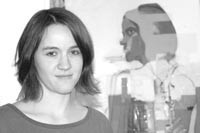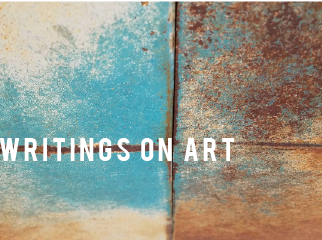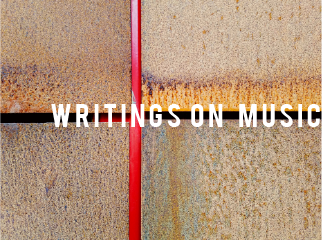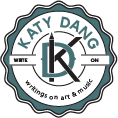Kelly Packer
“Bones and Piss: Artist Kelly Packer exalts the commonplace”
By Katy Dang
Boise Weekly | November 8, 2006
https://www.boiseweekly.com/boise/bones-and-piss/Content?oid=930094

Kelly Packer is not a saint.
Although the paintings that she has created from her own image have been used to portray saints, they are less self-portraits than images culled for their convenience and proximity to the artist. They are not intended to represent her as a saint; far from it. “It is me embodying the idea of a saint,” she explains. “By elevating myself and those around me to saintly positions, I artificially grant us credibility, a higher status.” Her work is striking, and Packer may currently have one of the most recognizable profiles in Boise. The set jaw and intense brown eyes are the first thing to catch the eye, but the colors and spaces of the figure draw the viewer in. Many of her images are overlaid with skeletal fragments, the pieces of bone providing a glimpse into a sometimes surprising infrastructure.
“Saints are made of jawbones and piss,” she writes in her artist’s statement. “This is both their downfall and their beauty. Trapped by their bodies in an attempt to reach Heaven, they are anchored by minerals and gravity, the ever-present pull of the earth.” Packer’s interpretations and inventions of the saints elevate the commonplace to exalted status. One of her paintings, titled Apollonia—mandible or mother tongue/ is this the texture of speaking/ or is it your jaw popping in its sockets–is a representation of the patron saint of dentistry.
These images, along with some of her earlier paintings, first appeared in the local art scene at the Hyde Park Gallery two years ago, when the space first opened. Ten pieces of her work were selected for their inaugural show. She was also selected to be a featured artist in their first “Emerging Artists” show in July 2006. “She has a keen eye for certain things and a unique feel for how she presents her images,” says gallery owner Joe Widmar.
Packer’s saintly image in the painting Inversion Halo also made quite a splash at the Boise Open Studios Collective Organization preview show at the Boise Art Museum in 2005. “I remember the first time I saw her work (at the BOSCO reception), I was blown away,” says Amy Westover, the artist who organized the show. “I had never heard of her until that day and her painting was so beautiful and intriguing. The paintings I have seen since have only gotten better and more deserving of attention.”
The paintings of the sainted are quite a departure from Kelly’s earlier work, which had a decidedly architectural feel to it. The recent inclusion of bones belies her fascination with underlying structures. Bridges and lampposts, power poles and attaching wires, and the inner lives of alleys and streets were her earlier subjects. “I used to take walks and take pictures of underpasses,” she says.
“I’ve always worked from photographs, to some extent,” says Packer. “I can’t just imagine a subject; I have to have something in front of me to work from.” After that, it becomes a process of drawing, erasing and painting. ” I never think of them as separate,” she says. ” I go back and forth between painting and drawing, layering one over the other.”
Kelly was born in Kalispell, Montana in 1979 and grew up in Montana for most of her life. During high school, she was a member of the art club. “I think I actually lettered in art,” she says. She attended the University of Montana in Missoula, where she started out majoring in journalism. “At some point, I got the courage to switch my major to art,” recalls Packer. “We had an assignment to interview a cop and I just said, ‘No, I’m not going to do this.’ I just didn’t go.” She started taking drawing fundamentals. “I had to hear a lot of “What are you going to do with an art degree?'” says Packer. “I still get that a lot.” Like art students everywhere, she ignored the (somewhat rhetorical) question and pursued her interest, forsaking a potential career path to follow her eye.
She had one memorable painting instructor, MaryAnn Bonjorni, who was “full-force committed” to teaching her students how to function, realistically, as artists. “She had all these strange requirements, like ‘You must get a pickup truck,'” says Packer. “It seemed kind of odd at the time, but she was actually right. You need to have some way to move your work around.” Packer has maintained a practical approach to her art, and has maintained her day job rather than becoming a full-time artist. “It gives me the liberty of not focussing on sales, ” she says. She likes the freedom to be able to work on whatever she wants to. “Photography, collage, painting–I don’t think of them as being different things,” she explains. “It’s all one thing: it’s art.”
As an artist, Packer is a work in progress herself, which is both refreshing and appropriate for her age and for this stage in her artistic development. She has surrounded herself with images that she can cull from, and has the flexibility and the spirit to try any number of things. Take, for example, her collaborative performance art. She usually works with her partner of five years, Adrian Kien, who is a graduate student in creative writing at Boise State. A recent First Thursday crowd in downtown Boise was treated to the spectacle of Kelly ripping Adrian’s guts open with a knife, which caused hot dogs smothered in ketchup to spill out. Kelly and a few well-placed individuals then treated themselves to a delicious feast in a performance they called “Hot Dog Incarnate.” The spontaneity appeals to Packer, and she and Adrian plan to create more happenings around town when the mood and the right idea strikes them. “I like the idea of little improv shows that get together for one night,” says Packer. “We’re both pretty shy, so this is our way of getting on stage.”
In Montana, Packer and Kien put on Alley Shows, where they would hang art in a downtown alley for a single night. The intention was not to sell anything–“We didn’t even have a price list or anything”–but was in itself a creative act: the transformation of a side street into a gallery. “It seems like with us, it’s just sort of a way of life,” she explains. “It’s not like it’s all about putting it on the walls.”
In her most recent work, she is using images of animals taken from taxidermy, and these sacrificed creatures are sainted by Packer as well. “I like this idea of melding animal and human, intermixing internal organs and animal and everyday elements” she says. “Things that don’t look quite right, biologically engineered. You know it’s wrong for some reason, but it’s also beautiful. I like that terrifying beauty. And then I validate them with historical and quasi-religious elements.”
Such is the canonization of her subjects, the exalted status as pronounced by their maker. They are something to behold.



